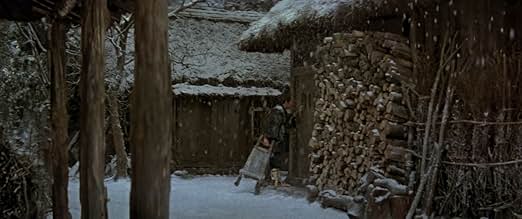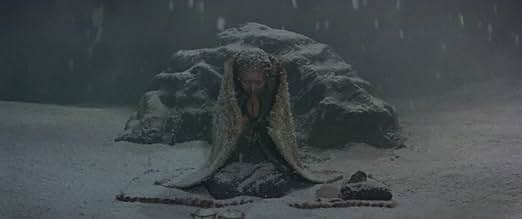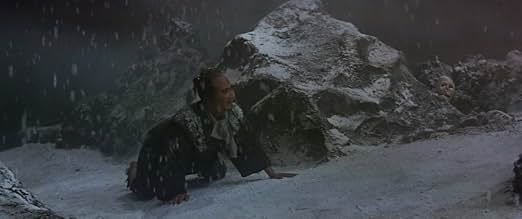IMDb रेटिंग
7.8/10
4 हज़ार
आपकी रेटिंग
अपनी भाषा में प्लॉट जोड़ेंA kabuki theatre-inflected story about a poor village whose people have to be carried to a nearby mountain to die once they get old.A kabuki theatre-inflected story about a poor village whose people have to be carried to a nearby mountain to die once they get old.A kabuki theatre-inflected story about a poor village whose people have to be carried to a nearby mountain to die once they get old.
- निर्देशक
- लेखक
- स्टार
- पुरस्कार
- 6 जीत और कुल 1 नामांकन
फ़ीचर्ड समीक्षाएं
In Kabuki style, the film tells the story of a remote mountain village where the scarcity of food leads to a voluntary but socially-enforced policy in which relatives carry 70-year-old family members up Narayama mountain to die.
Roger Ebert of the Chicago Sun-Times rated the film a maximum 4 stars, and added it to his Great Movies list in 2013, making it the final film he added to the list before his death. In a June 1961 review in The New York Times, A.H. Weiler called the film "an odd and colorful evocation of Japan's past that is only occasionally striking"; "It is stylized and occasionally graphic fare in the manner of the Kabuki Theatre, which is realistically staged, but decidedly strange to Western tastes." I have to respectfully disagree with Weiler. Perhaps at the time the film was strange to Western taste. I couldn't speak to that. But I find it quite refreshing, and really enjoy how they made it obvious that the story was told on a stage. Rather than hide the stag as American films do, this one embraces it, so you know you are really watching a story and it need not be any more than that. And yet, it is not just theater but a bigger experience.
Roger Ebert of the Chicago Sun-Times rated the film a maximum 4 stars, and added it to his Great Movies list in 2013, making it the final film he added to the list before his death. In a June 1961 review in The New York Times, A.H. Weiler called the film "an odd and colorful evocation of Japan's past that is only occasionally striking"; "It is stylized and occasionally graphic fare in the manner of the Kabuki Theatre, which is realistically staged, but decidedly strange to Western tastes." I have to respectfully disagree with Weiler. Perhaps at the time the film was strange to Western taste. I couldn't speak to that. But I find it quite refreshing, and really enjoy how they made it obvious that the story was told on a stage. Rather than hide the stag as American films do, this one embraces it, so you know you are really watching a story and it need not be any more than that. And yet, it is not just theater but a bigger experience.
It gets a little tedious to relate current events to old movies so apologies dear reader, but while watching this film I couldn't help but think of the heartless voices in American politics that suggested old people sacrifice themselves for the good of the economy during the pandemic this year. It also made me think of Make Way for Tomorrow (1937) and Midsommar (2019), and maybe that's all you need to know (and then some).
Bless the little old lady at its center (Kinuyo Tanaka) - she's so sweet, and certainly contributes to the family by catching fish, hauling the harvest, and cooking, which makes her treatment even more heartbreaking. Whether the practice of obasute is legendary or not, it's easy to see a real-world parallel to how older people are too often forgotten, shoved aside, or abused, which may touch some painful chords in the viewer.
Here we see cruelty that is at times blunt (her annoying-as-hell grandson), ritualized (perhaps to help rationalize it), and in some sense born out of brutal economic need (food is a luxury, and making white rice once a year is a special treat). It all reflects losing our humanity with how we treat the elderly. The film lags a little bit in its last half hour, but it absolutely brims with emotion. The kabuki styling of the storytelling from director Keisuke Kinoshita is delightful, and made me think of our painful little lives as on the stage, each in one role today, and another tomorrow.
Bless the little old lady at its center (Kinuyo Tanaka) - she's so sweet, and certainly contributes to the family by catching fish, hauling the harvest, and cooking, which makes her treatment even more heartbreaking. Whether the practice of obasute is legendary or not, it's easy to see a real-world parallel to how older people are too often forgotten, shoved aside, or abused, which may touch some painful chords in the viewer.
Here we see cruelty that is at times blunt (her annoying-as-hell grandson), ritualized (perhaps to help rationalize it), and in some sense born out of brutal economic need (food is a luxury, and making white rice once a year is a special treat). It all reflects losing our humanity with how we treat the elderly. The film lags a little bit in its last half hour, but it absolutely brims with emotion. The kabuki styling of the storytelling from director Keisuke Kinoshita is delightful, and made me think of our painful little lives as on the stage, each in one role today, and another tomorrow.
Kinoshita is a director who seems to have two distinct reputations - his Japanese reputation as a beloved and critically acclaimed filmmaker of long standing - and his western reputation as a technically adept but conservative and overly sentimental director, not someone in the same class as Kurosawa, Ozu, etc. This movie seems to sum up why this could be.
Its based on a classic old story, about a son who's duty is to bring his elderly mother to a mountain to die, in line with local tradition. This tradition is a rational response to extreme poverty, where infanticide is the normal form of birth control and the old are seen as too much of a burden for poor families. The mother is determined to go with dignity, to meet the gods on Mount Narayama - the loving widowed son is desperate to dissuade her. His older son and daughter in law are hateful, immature and greedy, more than willing to see the grandmother go if it means more food for them.
The story is told in a highly theatrical, staged style, and narrated and acted as if it were a kabuki play. It even starts with a curtain parting. This would have been familiar to early Japanese film goers as the roots of Japanese cinema was in filmed theater, rather than in representational forms (i.e. 'moving pictures') as in most other countries. So, while this seems a somewhat contrived and arty approach to a modern western viewer, to the contemporary Japanese audience it would have been familiar and natural.
The staging is beautiful and it is a very moving story, with some gorgeous sets and lighting. Kinuyo Tanaka is particularly moving as the old lady (she was also a director in her own right). One source book (by David Thompson) claims she actually had her teeth removed to make the movie, although I'd be a bit skeptical about that (this sounds to me like the sort of thing a publicist would invent). Like similar movies such as the Kon Ichikawas superior 'An Actors Revenge', this movie is a very accessible introduction to viewers to traditional Japanese forms.
A solemn and formal film like this could be boring, but its a tribute to Kinoshita and the actors that it is always gripping and powerful. However, it also exposes his weaknesses as a director, as the story is used purely for aesthetic purposes, and with the sorrow of the son being used to grab our sympathies, but there is no element whatever of a condemnation of a society that allowed this to happen, or for that matter an exploration of the psychological implications of this on the individuals in a society. I would have expected any of the more astute and radical directors of the time (such as Masumura or Ichikawa) to have used this basic story as a way of critiquing Japanese society or exploring what this sort of situation tells us about ourselves. In this way, the movie is essentially quite shallow and conservative.
Its based on a classic old story, about a son who's duty is to bring his elderly mother to a mountain to die, in line with local tradition. This tradition is a rational response to extreme poverty, where infanticide is the normal form of birth control and the old are seen as too much of a burden for poor families. The mother is determined to go with dignity, to meet the gods on Mount Narayama - the loving widowed son is desperate to dissuade her. His older son and daughter in law are hateful, immature and greedy, more than willing to see the grandmother go if it means more food for them.
The story is told in a highly theatrical, staged style, and narrated and acted as if it were a kabuki play. It even starts with a curtain parting. This would have been familiar to early Japanese film goers as the roots of Japanese cinema was in filmed theater, rather than in representational forms (i.e. 'moving pictures') as in most other countries. So, while this seems a somewhat contrived and arty approach to a modern western viewer, to the contemporary Japanese audience it would have been familiar and natural.
The staging is beautiful and it is a very moving story, with some gorgeous sets and lighting. Kinuyo Tanaka is particularly moving as the old lady (she was also a director in her own right). One source book (by David Thompson) claims she actually had her teeth removed to make the movie, although I'd be a bit skeptical about that (this sounds to me like the sort of thing a publicist would invent). Like similar movies such as the Kon Ichikawas superior 'An Actors Revenge', this movie is a very accessible introduction to viewers to traditional Japanese forms.
A solemn and formal film like this could be boring, but its a tribute to Kinoshita and the actors that it is always gripping and powerful. However, it also exposes his weaknesses as a director, as the story is used purely for aesthetic purposes, and with the sorrow of the son being used to grab our sympathies, but there is no element whatever of a condemnation of a society that allowed this to happen, or for that matter an exploration of the psychological implications of this on the individuals in a society. I would have expected any of the more astute and radical directors of the time (such as Masumura or Ichikawa) to have used this basic story as a way of critiquing Japanese society or exploring what this sort of situation tells us about ourselves. In this way, the movie is essentially quite shallow and conservative.
Made available on Blu-ray by the Criterion Collection, Kinoshita's highly stylized exploration of the Narayama story is a deliciously stunning exploration of the possibilities of colour, and has some of the most inventive use of transition in film.
You might be familiar with the far more explicit and naturalistic film version of the same story from 1983, made by Shôhei Imamura, and knowledge of that film greatly enhanced my viewing of this. These two films are worlds apart, in fact so much that it feels that Imamura's film openly converses with this, since its theatricality seems to almost provoke the kind of hyper-naturalism inherent in the Imamura. Another film that enriches this is Kinugasa's "Jigokumon" ("Gates of Hell", 1953), available on Region B Blu-ray courtesy of the Masters of Cinema, and soon to be released by Criterion, as well.
I didn't know much of Kinoshita before this, only the biographical information concerning his relationship with Masaki Kobayashi, who served as his apprentice and whose film "Harakiri" (1962) Kinoshita openly disliked (he reversed his opinion later). I think it's somewhat ironic since Kobayashi's use of lighting certainly finds a compeer here, and I think this definitely encouraged "Kwaidan" (1964) to go to the lengths it did.
You might be familiar with the far more explicit and naturalistic film version of the same story from 1983, made by Shôhei Imamura, and knowledge of that film greatly enhanced my viewing of this. These two films are worlds apart, in fact so much that it feels that Imamura's film openly converses with this, since its theatricality seems to almost provoke the kind of hyper-naturalism inherent in the Imamura. Another film that enriches this is Kinugasa's "Jigokumon" ("Gates of Hell", 1953), available on Region B Blu-ray courtesy of the Masters of Cinema, and soon to be released by Criterion, as well.
I didn't know much of Kinoshita before this, only the biographical information concerning his relationship with Masaki Kobayashi, who served as his apprentice and whose film "Harakiri" (1962) Kinoshita openly disliked (he reversed his opinion later). I think it's somewhat ironic since Kobayashi's use of lighting certainly finds a compeer here, and I think this definitely encouraged "Kwaidan" (1964) to go to the lengths it did.
"The balad of Narayama" is about the so called "Ubasute". An elderly person is carried to a mountain and left there to die. According to recent insights "ubasute" is an ancient legend and was never a real practice.
Wit an aging population the relevance of this myth is rising also in the Western world, if only as warning againt tensions between the generations. In the Netherlands there were some ugly discussions about elderly people occupying scarce intensive care capacity at the beginning of the Covid pandemic.
The 1958 version of "The balad of Narayama" is less well known as the movie of the same name by Shohei Imamura from 1983. It differs in two respects.
In the first place there is a material difference. In this movie the center of gravity is on the different ways that people can handle and accept their own mortality. In the Imamura movie the accent is on the battle between the generations for the scarce food supplies (or scarce health care capacity in my example given anbove).
In the second place there is a stylistic difference. This movie is much more artificial, reminding of the traditional Japanese Kabuki drama. In its artificiality of the use of colors it also reminds of "Kwaidan" (1964, Masaki Kobayashi).
I like the version of Keisuke Kinoshita better then the later one of Shohei Imamura. The reason being, I think, that the stylistic artificiality is better suited for the mythical character of the story.
Wit an aging population the relevance of this myth is rising also in the Western world, if only as warning againt tensions between the generations. In the Netherlands there were some ugly discussions about elderly people occupying scarce intensive care capacity at the beginning of the Covid pandemic.
The 1958 version of "The balad of Narayama" is less well known as the movie of the same name by Shohei Imamura from 1983. It differs in two respects.
In the first place there is a material difference. In this movie the center of gravity is on the different ways that people can handle and accept their own mortality. In the Imamura movie the accent is on the battle between the generations for the scarce food supplies (or scarce health care capacity in my example given anbove).
In the second place there is a stylistic difference. This movie is much more artificial, reminding of the traditional Japanese Kabuki drama. In its artificiality of the use of colors it also reminds of "Kwaidan" (1964, Masaki Kobayashi).
I like the version of Keisuke Kinoshita better then the later one of Shohei Imamura. The reason being, I think, that the stylistic artificiality is better suited for the mythical character of the story.
क्या आपको पता है
- ट्रिवियाThis was the final film to be added to Roger Ebert's list of "Great Movies" before his death on April 4, 2013 at the age of 70.
- कनेक्शनFeatured in Tvennesnack: Varför kan vi inte komma ihåg den här jävla filmen? (2022)
टॉप पसंद
रेटिंग देने के लिए साइन-इन करें और वैयक्तिकृत सुझावों के लिए वॉचलिस्ट करें
- How long is The Ballad of Narayama?Alexa द्वारा संचालित
विवरण
- रिलीज़ की तारीख़
- कंट्री ऑफ़ ओरिजिन
- भाषा
- इस रूप में भी जाना जाता है
- The Ballad of Narayama
- फ़िल्माने की जगहें
- उत्पादन कंपनी
- IMDbPro पर और कंपनी क्रेडिट देखें
इस पेज में योगदान दें
किसी बदलाव का सुझाव दें या अनुपलब्ध कॉन्टेंट जोड़ें





























